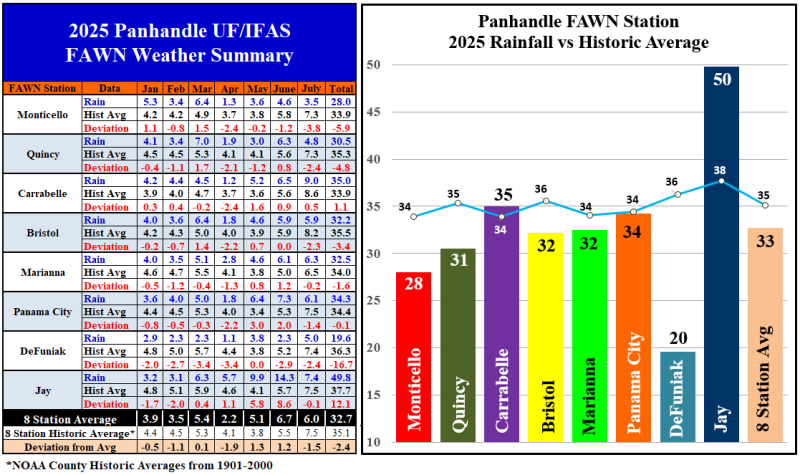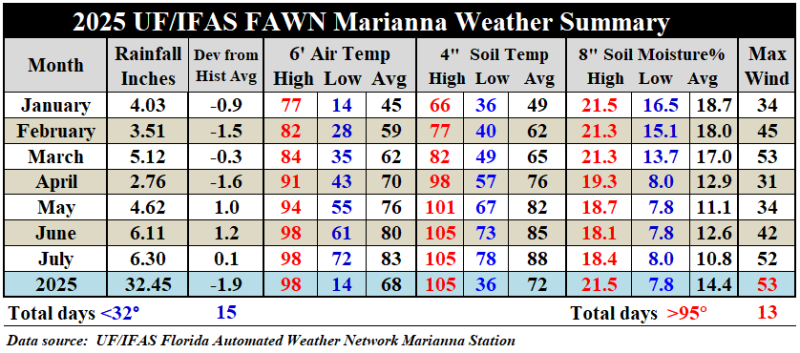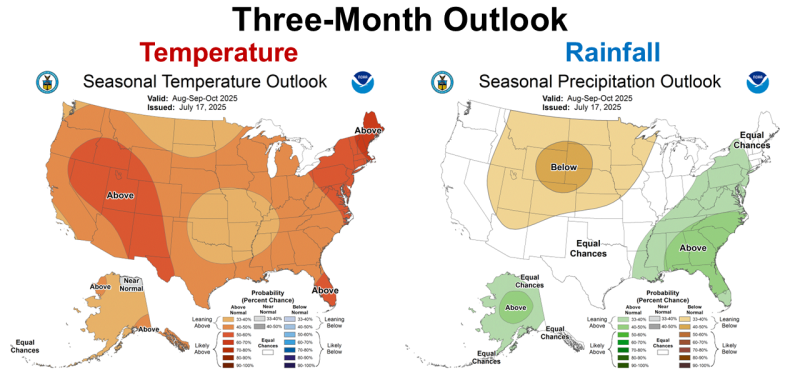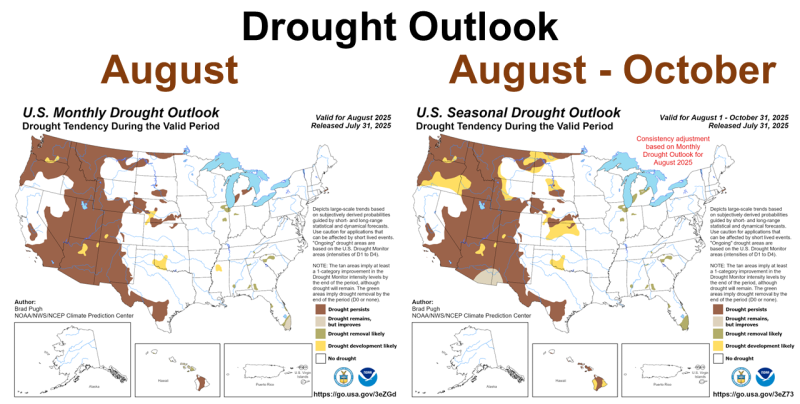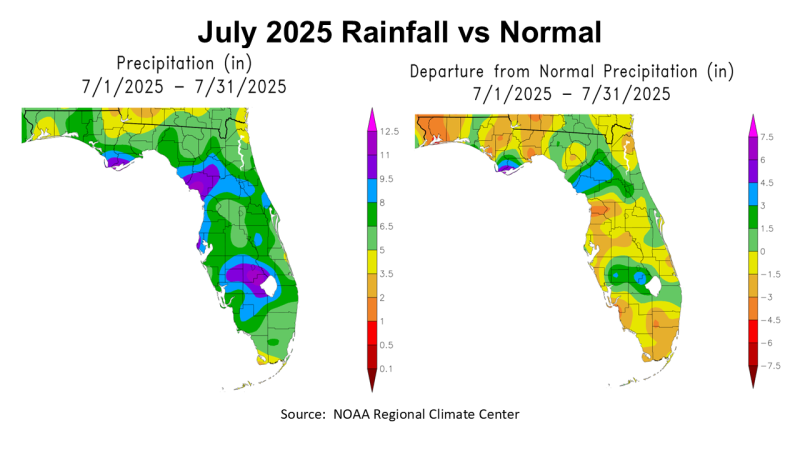 Rainfall
Rainfall
July is normally one of the wettest months of the year, but it was not uniform this year across the Panhandle. In July 2025, NOAA’s Regional Climate Center estimates that total rainfall ranged from 2-3.5″” (tan) to 9.5-11″ (purple) across the Panhandle (map to left above). The map to the right above shows how 2025 July rainfall compared with historic average. Only parts of Bay, Gulf, Franklin, Liberty, Walton, Holmes, and Jefferson counties were above average (green) in 2025, with the rest of the region below average.
–
The eight Florida Automated Weather Network (FAWN) stations provide more precise data across the Panhandle, in July. The wettest location was in Jay with 7.4″ in July, which was actually -0.1″ below historic average. By contrast, the Monticello station recorded only 3.5″, -3.8″ below normal. The average for all eight stations in July was 6.0″, which was -1.5″ below average.
From January through July 2025, the average for all eight stations was 32.7″, which was -2.4″ below average. In the bar graph above you can easily see that the only stations that have been above average in 2025 so far were at Carrabelle and Jay. The 49.8″ that was collected in Jay was by far the wettest location, which was 12.1″ above normal. The DeFuniak Springs FAWN Station has recorded 19.6″ so far in 2025, -16.7″ below normal.
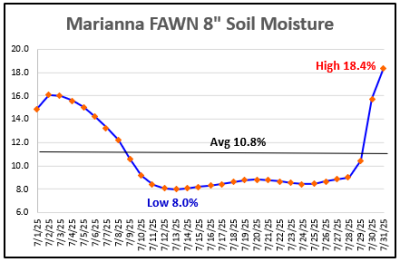 New for 2025, each FAWN station measures soil moisture at different soil depths (4“, 8″, 12″, 16″, or 20”). The chart to the right shows the changes to soil moisture from the Marianna FAWN Station at the 8″ depth over the month of July. The percentage of moisture ranged from a low of 8% on July 13th to a high of 18.4% on July 31st. The average for July was 10.8%, compared to 12.6% in June, and 11.1% in May. This is pretty telling information in this chart, because the 6.3″ of total rainfall measured at the Marianna FAWN was only 0.2″ below normal, yet you can clearly see that over the middle of the month, plants were stressed, and irrigation was certainly warranted from July 9 to July 29.
New for 2025, each FAWN station measures soil moisture at different soil depths (4“, 8″, 12″, 16″, or 20”). The chart to the right shows the changes to soil moisture from the Marianna FAWN Station at the 8″ depth over the month of July. The percentage of moisture ranged from a low of 8% on July 13th to a high of 18.4% on July 31st. The average for July was 10.8%, compared to 12.6% in June, and 11.1% in May. This is pretty telling information in this chart, because the 6.3″ of total rainfall measured at the Marianna FAWN was only 0.2″ below normal, yet you can clearly see that over the middle of the month, plants were stressed, and irrigation was certainly warranted from July 9 to July 29.
–
The Florida Drought Monitor shows that much of North Florida got abnormally dry near the end of July, but Central Florida showed significant improvement as compared to the start of July. The area south of lake Okeechobee has been in drought most of 2025 and was worse at the end of July.
–
Temperatures
 July was another hot summer month. The chart to the right shows the variation in the high and low temperatures at the Marianna FAWN Station. The low for the month was 72° on July 12 and the high was 98° on July 15. There were eight days with high temperatures over 95°, but also 15 days with measurable rainfall. The average temperature for the month was 83°.
July was another hot summer month. The chart to the right shows the variation in the high and low temperatures at the Marianna FAWN Station. The low for the month was 72° on July 12 and the high was 98° on July 15. There were eight days with high temperatures over 95°, but also 15 days with measurable rainfall. The average temperature for the month was 83°.
The soil was very hot as well, with a high of 105° on July 10 and a low of 78° on June 2, at the 4″ depth. It is no wonder that the soil dried out so much in the middle of the month. The average soil temperature was 88°.
Looking at a summary chart of the weather data from January through June from Marianna, you can see that the average air temperature increased 3°, 80° in June to 83° in July. The soil also warmed up 3° in July, from an average soil temperature of 85° in June to 88° in July. It is also interesting to look at the changes in average soil moisture from month to month, no doubt getting drier because of the heat of this summer. There was also a thunderstorm with 52 mph winds in July, the highest total since March.
–
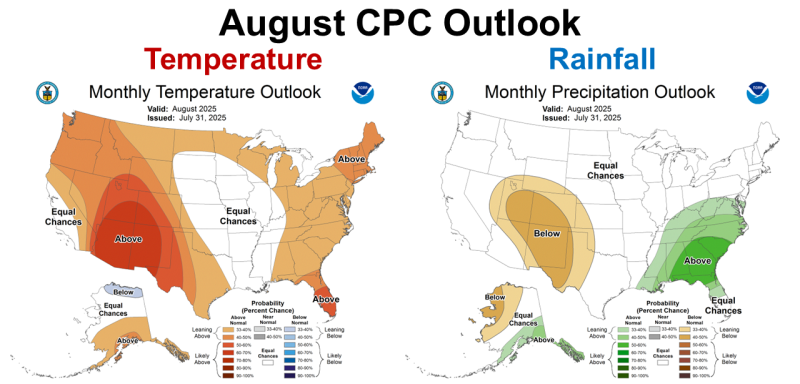 Climate Outlook
Climate Outlook
The Climate Prediction Center (CPC) is expecting August to continue the trend of another hotter than average month, with most of the Southeast expected to also have higher than average rainfall. The first week of August certainly agrees with this possibility, but we will see how the rest of the month turns out. Most of the Panhandle has actually been slightly below average for rainfall so far this summer.
–
The longer ranged, three-month outlook is very similar, as the CPC expects the entire U.S.to be hotter than normal through October, with higher-than-average rainfall for almost the entire Eastern Seaboard. So, the expectation is that the heat is long from over, but we can expect adequate moisture to close out the crop and forage growing season.
–
The August and Seasonal Drought outlook maps above show the expectation of drought improvement for the entire state of Florida in August, but removal from the drought category for the Southern tip of Florida may not happen until later this fall.
–
ENSO Outlook
The current ENSO outlook summary is not much different than last month’s but will be updated again on August 14. There is a distinct possibility of La Niña in late fall and early winter, but it is still too soon to make a call on that. At this point in the year, the scientists cannot make a clear determination.
ENSO-neutral is present. Equatorial sea surface temperatures (SSTs) are near average across most of the Pacific Ocean. ENSO-neutral is most likely through the late Northern Hemisphere summer
2025 (56% chance in August-October). Thereafter, chances of La Niña conditions increase into the fall and winter 2025-26 but remain comparable to ENSO-neutral. August 4 – Climate Prediction Center
So, what does this mean for Panhandle Farmers and Ranchers?
The heat has certainly been a factor this summer, and it appears that trend will continue. Above average rainfall is expected over the next three months, so crops and pastures should stay in decent shape. Rainfall this summer has not been uniform at all, but much of the Panhandle has been near average. The Western Panhandle Counties have seen much higher rainfall totals this year. Tropical storm season is beginning to ramp up, so there could still be significant impact from a major storm, but the forecast is still positive to close out the growing season. This is a year to stay vigilant scouting for fungal diseases such as late leaf spot in peanuts. Producing baleage may be a better option than trying to find a multiple-day window for hay production over the next month or two. There is potential for La Niña later this fall, but it is still too early to have a good handle on what to expect this fall/winter. Check back next month to see what the experts predict for this fall and winter.
- July 2025 Weather Summary & 3-Month Outlook - August 8, 2025
- Friday Funny Feature:Not Until the Tractor’s Paid Off - August 8, 2025
- Friday Feature:Replacement Heifer Development 101 - July 31, 2025

